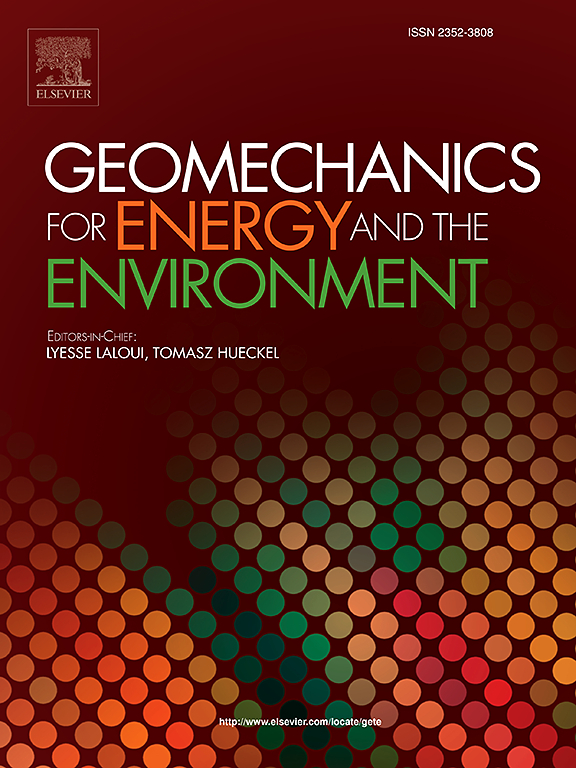Early and post-stage piping erosion in bentonite buffer materials exposed to groundwater inflow
IF 3.7
2区 工程技术
Q3 ENERGY & FUELS
引用次数: 0
Abstract
Piping erosion presents a significant concern in engineered barrier system (EBS), contributing to performance uncertainties. However, the early-stage hydration and piping erosion characteristics of calcium-type bentonite under concentrated water inflow conditions are not fully understood. To address this gap, we examined early- and post-stage piping erosion in bentonite buffer materials. Specifically, we focused on the onset and evolution of piping channels with changes in the inflow pressure and their impact on buffer material integrity. Piping experiments were conducted using bentonite in block, granule, and powder forms under constant flow rate conditions. We analyzed the hydraulic-mechanical responses at the bentonite-cell interface, fluctuations in inflow water pressure, and eroded soil mass. Additionally, X-ray computed tomography imaging was utilized to assess the deterioration of buffer materials after piping. The results revealed that early-stage hydration-induced erosion behaviors are contingent upon the state of the bentonite buffer, with compacted blocks exhibiting predominant piping erosion. The rapid pressure buildup and breakthrough is essential in triggering piping erosion in the blocks, while the evolution of piping channels is influenced by the flow rate. Furthermore, severe cracks occurred along with the piping channels under reduced flow rate conditions, creating voids in the buffer amounting to 1.5–3.1 % of its initial volume. These findings provide insights into buffer-rock interfacial interactions in EBS, serving as the basis for in situ disposal experiments and the safe design of disposal repositories.
暴露于地下水流入的膨润土缓冲材料的早期和后期管道侵蚀
管道侵蚀是工程阻隔系统(EBS)的一个重要问题,也是造成性能不稳定的原因之一。然而,钙基膨润土在高浓度水流入条件下的早期水化和管道侵蚀特性尚未得到充分了解。为了填补这一空白,我们研究了膨润土缓冲材料的早期和后期管道侵蚀。具体来说,我们重点研究了随着流入压力的变化而出现的管道侵蚀及其对缓冲材料完整性的影响。我们使用块状、颗粒状和粉末状膨润土在恒定流速条件下进行了管道实验。我们分析了膨润土-池体界面的水力机械响应、流入水压的波动以及被侵蚀的土壤质量。此外,我们还利用 X 射线计算机断层扫描成像技术来评估管道铺设后缓冲材料的劣化情况。研究结果表明,早期水化诱发的侵蚀行为取决于膨润土缓冲区的状态,压实块体在管道侵蚀中占主导地位。压力的快速积累和突破是引发块体中管道侵蚀的关键,而管道通道的演变则受到流速的影响。此外,在流速降低的条件下,管道通道出现了严重的裂缝,在缓冲区内形成了占初始体积 1.5% 到 3.1% 的空隙。这些发现深入揭示了 EBS 中缓冲区与岩石的界面相互作用,为原位处置实验和处置库的安全设计提供了依据。
本文章由计算机程序翻译,如有差异,请以英文原文为准。
求助全文
约1分钟内获得全文
求助全文
来源期刊

Geomechanics for Energy and the Environment
Earth and Planetary Sciences-Geotechnical Engineering and Engineering Geology
CiteScore
5.90
自引率
11.80%
发文量
87
期刊介绍:
The aim of the Journal is to publish research results of the highest quality and of lasting importance on the subject of geomechanics, with the focus on applications to geological energy production and storage, and the interaction of soils and rocks with the natural and engineered environment. Special attention is given to concepts and developments of new energy geotechnologies that comprise intrinsic mechanisms protecting the environment against a potential engineering induced damage, hence warranting sustainable usage of energy resources.
The scope of the journal is broad, including fundamental concepts in geomechanics and mechanics of porous media, the experiments and analysis of novel phenomena and applications. Of special interest are issues resulting from coupling of particular physics, chemistry and biology of external forcings, as well as of pore fluid/gas and minerals to the solid mechanics of the medium skeleton and pore fluid mechanics. The multi-scale and inter-scale interactions between the phenomena and the behavior representations are also of particular interest. Contributions to general theoretical approach to these issues, but of potential reference to geomechanics in its context of energy and the environment are also most welcome.
 求助内容:
求助内容: 应助结果提醒方式:
应助结果提醒方式:


